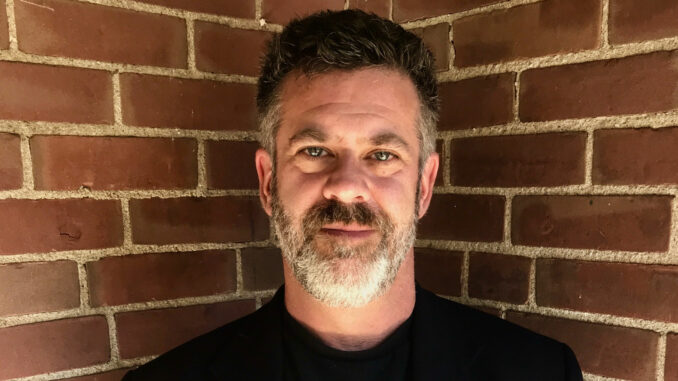
Margaret Atwood is the most famous writer to come from Leaside. Everyone knows that. But not everyone knows that Michael Redhill lives here with his wife and two stepsons. Poet, playwright, and novelist, Redhill is the author of Consolation, long-listed for the 2007 Man Booker Prize; Martin Sloane, a finalist for the 2001 Giller Prize; and Bellevue Square, the winner of the 2017 Giller Prize. His poetry and plays have also won numerous awards. Garnering prizes and awards, however, does not necessarily make a writer wealthy. Redhill told me that he was down to his last $411.64 before cashing the $100,000 cheque that comes with winning the Giller.
Redhill spent his formative years in North York and attended York Mills Collegiate. He finished his formal education at York University and the University of Toronto, studying film and literature. He made Leaside his home because his family has dwelled in Toronto and its environs for two and a half generations. His mother and brother live 500 metres away from his house in the ’hood. He has written an as yet unpublished poem about Leaside, “Our Midden,” which speculates about the history buried in the backyards of our town.
From the time he was a young adolescent armed with his instamatic camera, he saw Toronto as unexplored territory and was struck by how little people knew about its topography and history. Cameras and pictures figure in his fiction, especially in Consolation, whose present-day narrative set in 1990s Toronto is juxtaposed with a historical narrative set in 1850s Toronto. Redhill says that all of his writing is motivated by an unrelenting curiosity about the particularity of lived experience and by an ardent belief, not in the oneness of life, but in its infinite variety.
Like Kafka, Redhill knows how to compel the attention of a reader from the very first sentence. One of the most memorable openings in modern fiction comes from Kafka’s Metamorphosis: “One morning Gregor Samsa awoke after a night of unquiet dreams to find he had been transformed into a monstrous insect.” The opening of Bellevue Square can compete: “My Doppelganger problems began one afternoon in early April.” Thus begins Jean Mason’s obsessive search for her elusive double, a quest that takes her to occupy Bellevue Square, a park in the Kensington Market area where her double had been recently sighted, a double named Ingrid Fox, a double who turns out to be a writer of detective fiction.
All of Redhill’s novels are in some sense detective novels with strange, convoluted twists and turns. However, unlike in the traditional mystery story, there is no tidy resolution of loose ends. The novels refuse reassuring closure. In art, Redhill says, there are few happy endings that have an air of reality. To respect the intelligence of the reader, he maintains, it is necessary to avoid the solace of illusory coherence, “the artificially imposed catharsis of completed events.”
Redhill believes that nothing in life is ever completely finished. This open-endedness is a recurrent feature of the literary fiction he writes under his own name. The genre fiction he writes under the name of Inger Ash Wolfe more or less conforms to the conventions of the detective novel. He revealed himself to be the real author of those novels in 2012. Although he planned to write several more novels in the series featuring the no-nonsense middle-aged detective Hazel Micallef, the publisher pulled the plug after the fourth installment, The Night Bell (2015). He told me that for him Bellevue Square was an attempt to cope with the death of Inger Ash Wolfe, who takes the guise of Ingrid Fox in the novel, a novel that “encodes the relationship between author and pseudonym” and interrogates “the sovereignty of our selfhood,” that “crazy quilt of chemicals” that makes us who we uniquely are. He saw the book as “a note to [himself]” and was stunned that it was a nominee for the Giller Prize let alone the winner of it.
Redhill’s prose is worth savouring if only for its style and wit. Leasiders can certainly identify with his thoughts about the vagaries of winter. “May was on its way, thank God. We were getting inoculations of sun. Winter here arrives, stays, persists, goes away a little, then comes back and people start leaping off the bridges. That’s approximately March, when jumping is at its apogee, but even then, winter isn’t over. What it likes to do is go away for a week in April and then return for three days and finish Grandpa off.” In a simile worthy of Raymond Chandler, he puts before us a woman wearing “a layer of lipstick red as a car crash.” Jean calls her bookstore bookshop. “I do subtlety in other areas of my life,” she says.
Talking about critics who reviewed Ulysses when it first came out, James Joyce noted plaintively that they could have at least said it was funny. Michael Redhill is funny, in person and on paper. In one of my favourite passages from his Inger Ash Wolfe novel The Taken, the mother of Detective Inspector Hazel Micallef comments on a 20-year-old pop star “parading down a street in Hollywood in a dress big enough to cover a volleyball.”
“In a just society everything this child is doing would be illegal. She should be arrested, stuck in a housecoat, and made to listen to Guy Lombardo records until she smartens up.” Lombardo and the Royal Canadians billed themselves as creating “the sweetest music this side of Heaven.” For years, they did the New Year’s Eve Party at the Waldorf Astoria, and I painfully remember my parents annually subjecting me and my brothers to the telecast. The idea that Lombardo’s music would smarten up a hypersexualized nymphet is exquisitely absurd. I guess his music is sweet and heavenly for some, but I can imagine a 10th circle of hell wherein the condemned are forced to spend eternity listening to records by Guy Lombardo. Me? I would rather read novels by Michael Redhill.
This article was guest contributed by Greig Henderson.

